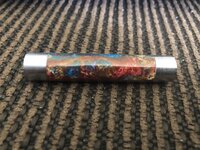Hi there! I just got done turning and finishing a blank for a Wall Street II Pencil Kit. When I took the blank off the lathe, I couldn't get the bushings out of the blank! I'm guessing this is from one of the following reasons....
1) The CA glue wasn't all the way dry. (Which I doubt because I waited about 15-20 min before mounting the blank on my lathe)
or
2) When I was using my pen mill, I might have gone down a bit too far and flattened the end of the tube by the smallest bit, making it a much tighter fit on the bushings.
In either case, I need to save my blank! It's my first blank I've ever casted myself and I want to do everything I can to save it! Any tips/tricks/advice would be greatly appreciated!
1) The CA glue wasn't all the way dry. (Which I doubt because I waited about 15-20 min before mounting the blank on my lathe)
or
2) When I was using my pen mill, I might have gone down a bit too far and flattened the end of the tube by the smallest bit, making it a much tighter fit on the bushings.
In either case, I need to save my blank! It's my first blank I've ever casted myself and I want to do everything I can to save it! Any tips/tricks/advice would be greatly appreciated!

